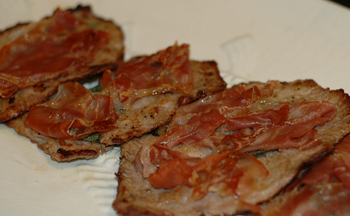 Probably the prize for the most unlikely title for a popular main dish should be awarded to the Romans. Some decades ago they concocted a veal cutlet creation using prosciutto ham and a leaf or two of sage as flavor accents. They gave it the most confounding label that would have the diner believe that the serving does not need a knife and fork because it simply “jumps in your mouth.” Saltimbocca alla Romana – the word “saltimbocca” being a fusion of the phrase “saltare in bocca.”
Probably the prize for the most unlikely title for a popular main dish should be awarded to the Romans. Some decades ago they concocted a veal cutlet creation using prosciutto ham and a leaf or two of sage as flavor accents. They gave it the most confounding label that would have the diner believe that the serving does not need a knife and fork because it simply “jumps in your mouth.” Saltimbocca alla Romana – the word “saltimbocca” being a fusion of the phrase “saltare in bocca.”
Hundreds of Italian cookbooks include this rather simple but tasty dish and uncharacteristically there is not much variation. The the only thing worth noting is that while all recipes call for pounding out thin slices of veal, only one cautions the unwary home chef about the biggest pitfall that will lead to a tough and chewy end result. That is failure to pound the meat so thin that it almost falls apart. The one exception I found is on my “go-to” Italian website Giallo Zafferano, wherein the video chef instructs the audience to pound the slices “as thinly as possible.” Good advice!
Veal pounded that thinly will cook in just over a minute on each side. There is not enough time to brown the meat to give it a more pleasing appearance. Thus some recipes call for dredging the scalloppine in flour and using high heat in the pan. But given that one side is covered with a slice of prosciutto the unappealing white color is not visible.
Nonetheless for the perfectionists I would try using the flour on the bottom side along with browned butter in the pan. I haven’t seen any recipes calling for browned butter but why not? The combination might give a better look as well as flavor to the final dish.
Dissecting this topic even further, the part I struggle with is pinning the sage and prosciutto slice to the veal. I’ve never encountered a toothpick in the dish at the Roman restaurants I visited. However Italian website videos consistently would have you serve the dish with toothpick and all. Not terribly appealing.
My version below claims success just by placing sage leaf and prosciutto firmly on the slice, cooking on the bare side for 1 minute or so at high heat and then flipping everything over carefully with a spatula as if it were a grilled cheese sandwich, cooking for another minute. Look ma no toothpick!
Also, the Italian recipes seem to want you to pin the sage, prosciutto and veal slice together with the sage leaf resting exposed on top of the slice. This does not work well.
Instead place the sage leaf on the veal slice and then put the prosciutto on top. Thus the sage is less likely to escape and wander around the dish as you devour the veal. Thanks to Mario Batali for recommending this very procedure in his recipe. However Mario also calls for the toothpick drill. Boo!
So for the nitpickers like me who want to execute a respectable “saltimbocca” without toothpicks follow these steps:
Saltimbocca alla Romana
for 4 persons
- 4 slices veal scallopine (5 ounces or so in weight each) pounded to about 1/8″ thickness. (Do not trust your butcher to do this since he or she is probably not from Rome and will certainly get it wrong).
- 4 slices prosciutto ham
- fresh sage leaves
- flour for dusting
- 3 tbsp. butter
- 1 cup medium dry white wine
- salt & pepper to taste
- lemon slice for garnish (optional)
Melt butter in a large saucepan on medium high heat. OK to brown the butter slightly if you choose. Meanwhile sprinkle slices on both sides with salt and pepper. Then dust one side of each veal slice with flour. On the other side place one or two fresh sage leaves and then cover with a prosciutto slice, trimming as necessary to avoid spilling over the edges of the meat.
Cook the veal slices 1 to 1 1/2 minutes per side taking care to flip without losing the prosciutto and the sage leaves. Holding the assemblage together with a finger tip while sliding the spatula underneath might help. Practice makes perfect.
Remove veal from the pan and deglaze pan with white wine. Pour the wine sauce over the veal and serve with lemon garnish. No toothpicks or utensils necessary.
